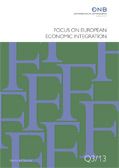Focus on European Economic Integration Q2/23
 OeNB
OeNB
- published:
- June 2023
 OeNB
OeNB
Economic trends in CESEE (PDF, 1.2 MB) Stubbornly high inflation despite cooling economy en Jun 1, 2023, 12:00:00 AM
Economic trends in the Western Balkans (PDF, 1.1 MB) en Jun 1, 2023, 12:00:00 AM
Green transition in CESEE: sectoral emissions and EU recovery plans
(PDF, 960 kB)
Breitenfellner, Lahnsteiner, Reininger.
The EU’s financial response to the pandemic was designed to also promote climate action. This descriptive study investigates to what extent the recovery and resilience plans (RRPs) of
EU member states in Central, Eastern and Southeastern Europe (CESEE) address some of the
most pressing issues regarding their greenhouse gas (GHG) emission levels compared with
other EU countries (EU-16). We assess that the ex ante allocation of spending within climate-
related RRP spending in CESEE EU countries appears to be broadly appropriate. First, their plans’ focus on renewable energy and networks is particularly important given that their per capita GHG emissions in energy industries were, on average, more than 50% higher than in the EU-16 in 2019, despite lower per capita GDP levels. These high emissions result, to a large extent, from a small group of economically significant countries that substantially use coal for power generation and district heating/cooling (as well as directly in the household sector). Given generous financial support, more ambitious coal-exit strategies could have been expected. Second, the focus of CESEE EU countries’ RRPs on energy efficiency is welcome,
given high energy intensity in manufacturing and poorly insulated buildings, which are an additional cause of high energy industries’ emission levels. In some countries, this area would
clearly deserve being made a higher spending priority. Third, the RRPs’ focus on sustainable
mobility is justified by the dynamic rise of transport sector emissions in CESEE EU (particularly in international aviation), even though per capita GHG emissions in transport are still lower in most CESEE countries than in the EU-16. While our findings support the general judgment that the RRPs’ spending structures indeed correspond to major country-specific climate-related weaknesses, we do not assess whether the plans are sufficient to put countries on track to their net-zero goals or whether individual measures are appropriate. Needless to say, the current energy crisis related to the Russian invasion in Ukraine and Russia’s earlier restrictions on gas exports already in 2021 adds to the urgent need to steer energy production and consumption away from fossil sources and to advance energy saving.
en
climate change, low-carbon transition, EU fiscal policy instrument, Central, Eastern and Southeastern Europe
O1, O52, Q54, Q56
Jun 1, 2023, 12:00:00 AM